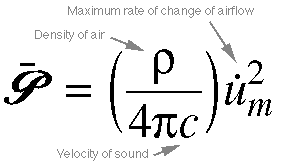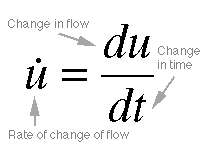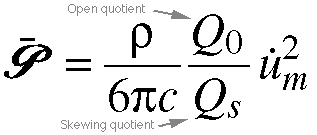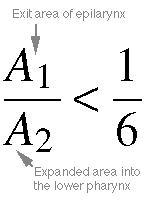Chapter 9: Control
of Vocal Intensity and Efficiency

Equation 9.1: The Inverse Square Law. Acoustic
energy is radiated from the mouth of a singer
as an expanding sphere. As time elapses,
this radiated energy gets distributed over
a larger and larger area, and so the sound
seems softer or weaker to us at a distance.
This equation quantifies the decay of that
energy. The radius R is the distance
of the observer from the sound source. This
law gets its name from the fact that intensity
is inversely proportional to the radius squared.

Equation 9.2a. Sound Intensity Level
(SIL), or Sound Pressure Level (SPL) as it
is usually called, is measured in decibels.
The SIL basically tells us how much louder
or more powerful a given sound is than a
standard (very soft) reference intensity,
which is 10-12 watt/m2.
This equation defines the sound intensity
level, and the next defines SPL:

Equation 9.2b. For SPL, a standard
reference pressure is used, instead of a
standard intensity. P0 is
this reference pressure, which is 20 micropascals
(0.00002 Pa). For our purposes, SIL and SPL
describe the same level of acoustic energy
and can be used interchangeably.

Equation 9.3. If we take Equations
9-1 and 9-2 and substitute in the standard
intensity, we get this, assuming a radius
of 0.5m. If we assume that a singer is producing
1 watt of acoustic power (the accepted maximum
power that human vocalists can produce),
then the SPL works out to 115 dB at 0.5m
away from the sound source.

Equation 9.4. If SPL is known and
we need to calculate the radiated power,
this equation is used.

Equation 9.5. This equation describes
the power radiating from a piston in a spherical
baffle, as shown in Figure 9.2b of the text.
This shape is similar to the vocal tract,
and so this idealized noisemaker is useful
in studying sound production in the voice.

Equation 9.6.

Equation 9.7.

Equation 9.8.

Equation 9.9.
Chapter
8 Equations Equations
Homepage Chapter
10 Equations
| 


